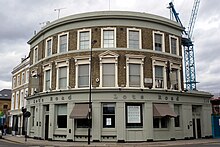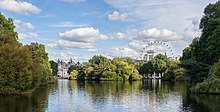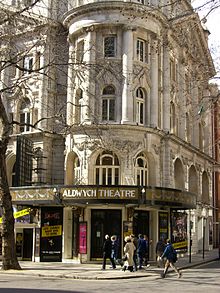Call for a dead
| Movie | |
|---|---|
| German title | Call for a dead |
| Original title | The Deadly Affair |
| Country of production | United Kingdom |
| original language | English |
| Publishing year | 1966 |
| length | 108 minutes |
| Age rating | FSK 16 |
| Rod | |
| Director | Sidney Lumet |
| script | Paul Dehn |
| production | Sidney Lumet |
| music | Quincy Jones |
| camera | Freddie Young |
| cut | Thelma Connell |
| occupation | |
| |
Call for the Dead is a British espionage thriller from 1966 by Sidney Lumet based on the novel Shadows of Yesterday (1961) by John le Carré . James Mason , Maximilian Schell and Simone Signoret play the leading roles.
action
London at the time of the Cold War in the 1960s. A senior Foreign Office official, Samuel Fennan, has committed suicide. Fennan was once a communist, so veteran MI5 agent Charles Dobbs is hired to investigate the alleged suicide more closely. The following morning, Dobbs visits Fennan's widow Elsa, a foreigner, and begins to question the suicide thesis. Some things about this matter do not seem conclusive to him, including a phone call for the dead Fennan that Elsa Fennan claims was for her. Why is the widow, a survivor of a German concentration camp, lying? Dobbs begins to assume that someone must have killed Fennan and that they are trying to manipulate him. But secret service man Dobbs has been in the business too long to be fooled. He persistently pursues the murder theory. This displeases his superior, and Dobbs is dismissed from the case.
The old spy fox, however, is not ready to be turned into a chess piece in dirty secret service games, gives up his job at MI5 and now begins to research on his own. Dobbs renews his private connection with retired Police Inspector Mendel to continue the investigation. Both men, who no longer have to be considerate of anyone and have nothing more to lose, uncover a network of communist agents. In his private life, things are not going well at Dobbs: He has to find out that his wife Ann is leaving him to go to Switzerland. There she meets a secret service colleague from the time of the Second World War , Dieter Frey. But what does Frey have to do with this case? Did he just lure Ann here to see if she could find out how far Dobbs' investigation had come? Soon all things start to slide completely. Dobbs uses his knowledge of Dieter to set a trap that proves that widow Elsa Fennan is an Eastern spy, directed by Dieter Frey. In the final confrontation, Dieter strangles Elsa and shoots Mendel, but Dobbs himself kills him with his bare hands.
Production notes
Call for a Dead was filmed on several locations in London in early 1966 and premiered in the British capital in October 1966. The German premiere took place on February 24, 1967, four weeks earlier the film had its New York premiere.
Denis O'Dell took over the production management. The film structures were designed by John Howell , the costumes by Cynthia Tingey. Brian West served as a simple cameraman under Chief Cinematographer Young.
Locations
The film was shot at the following locations in London: St. James's Park , the Balloon Tavern, the Serpentine Restaurant in Hyde Park and the Chelsea Embankment in the Chelsea district as well as in the districts of Clapham, Barnes and Twickenham. The exterior shots of Charles Dobbs' house were taken on St. George's Square in the Pimlico district. The scene with the theater performance of the Royal Shakespeare Company , the Christopher Marlowe's Edward II. Lists, was in Theater Aldwych added.
useful information
The central character of the Le Carré novel was actually called George Smiley , but could not be used for this film due to rights holder reasons.
Chief cinematographer Frederick A. Young designed his dull color photography in such a way that it always left the impression of very subdued coloring. Director Lumet thought this was necessary in order to create the gray paintwork of a gloomy London secret agent.
Film music
The following pieces of music by Quincy Jones can be heard:
- Who Needs Forever (3 minutes)
- Dieter's First Mistake (4 minutes 50 seconds)
- Main Instrumental Theme No. 1 (2 minutes 5 seconds)
- Postcard Signed "S" / Mendel Tails Elsa / Tickets to "S" (5 minutes 31 seconds)
- Main Instrumental Theme No. 2 (3 minutes)
- Don't Fly If It's Foggy (1 minute eleven seconds)
- Blondie-Tails (1 minute 13 seconds)
- Main instrumental theme No. 3 (2 minutes 5 seconds)
- Ridiculous Scene (1 minute 48 seconds)
- Body on Elevator (55 seconds)
- Bobb's at Gunpoint (45 seconds)
- Final title (42 seconds)
Jones conducted the orchestra himself with his own music. Hank Jones sat at the piano, Astrud Gilberto provided the vocals for the first piece, a bossa nova , the text of which was penned by Howard Greenfield .
Nominations
Call for a Dead received a plethora of award nominations, including five for the British Academy Film Award . But the film always came out empty-handed.
Reviews
Bosley Crowther wrote in the New York Times the day after the US premiere: “This latest film is interesting mainly because it provides a glimpse into the cheap and shabby life of a British counter-espionage agent stoically portrayed by James Mason. As a mystery thriller, the film causes a headache. (...) Well, secret agents are jaded, boring guys. The pictures above them don't have to be. "
The Movie & Video Guide found that a call for a dead offered a “top-notch suspense story”.
In the lexicon of international films it says: "Credible-looking, soberly staged spy story that offers above-average tension."
Halliwell's Film Guide found the film to be “a compelling, if cumbersome, thriller from the days of grouchy spies, deliberately kept desolate and photographed the shabbiest London backgrounds possible in muddy color. Solid entertainment for intellectual adults. "
Hal Erickson saw Call for a Dead "dark, complex espionage story."
Individual evidence
- ^ Full review in The New York Times, January 27, 1967
- ^ Leonard Maltin : Movie & Video Guide, 1996 edition, p. 309
- ↑ Call for a dead person. In: Lexicon of International Films . Film service , accessed January 17, 2020 .
- ^ Leslie Halliwell : Halliwell's Film Guide, Seventh Edition, New York 1989, p. 257
- ↑ Brief review on allemovie.com
Web links
- Call For A Dead in the Internet Movie Database (English)
- The Deadly Affair in Turner Classic Movies


